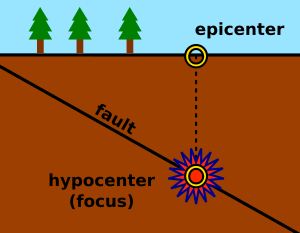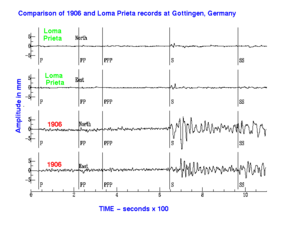Epicenter facts for kids
The epicenter is a very important spot when we talk about earthquakes. It's the exact point on the Earth's surface that is directly above where an earthquake actually starts deep underground. That starting point deep inside the Earth is called the hypocenter or focus.
Think of it like this: if you drop a ball into a pool, the splash on the surface is like the epicenter, and where the ball hit the water is like the hypocenter. The epicenter is also used to describe where an underground explosion begins.
Contents
How Scientists Find the Epicenter
Scientists use special tools called seismometers to find where earthquakes start. The main goal of a seismometer is to pinpoint the epicenter. Once they know the exact location, they can then figure out how big the earthquake was, which is called its magnitude.
Long ago, the first machines to detect earthquakes were very simple. For example, an ancient Chinese device would drop a ball in the direction of the earthquake. But these were not very precise.
Over time, these tools got much better. Scientists added a time scale to them. This meant they could record exactly when the ground started shaking. This led to the first seismograms, which are like graphs showing ground movement over time.
Using Waves to Find the Epicenter
When an earthquake happens, it sends out different types of waves. The first wave to arrive at a seismometer is called the P-wave (which stands for primary or compressional wave). Soon after, another wave arrives, called the S-wave (which stands for secondary or shear wave).
Scientists know that P-waves travel faster than S-waves. By measuring the time difference between when the P-wave and S-wave arrive at a seismometer, they can calculate how far away the earthquake happened.
Pinpointing the Location with Three Stations
Imagine you know how far away an earthquake is from one seismometer. This distance forms a circle around that seismometer, and the earthquake could be anywhere on that circle.
If you have two seismometers, you'll get two circles. These two circles will cross at two possible locations. To find the exact spot, you need a third seismometer. When you draw a third circle, all three circles will meet at just one point. That point is the earthquake's precise epicenter!
Today, scientists use many seismometers, often forming a network. Computers help them find the epicenter very accurately, sometimes within a kilometer or two. This helps them learn more about how faults work and how much danger an area faces from earthquakes.
Epicenter and Surface Damage
Before modern tools, people thought the epicenter was always where the most damage happened. However, the underground fault that causes an earthquake can be very long. This means the damage can spread out over a large area, not just right above the epicenter.
For example, in the 2002 Denali earthquake in Alaska, the epicenter was at one end of the fault rupture. But the worst damage was actually about 330 kilometers (205 miles) away at the other end!
Most earthquakes in continental areas start at depths between 2 to 20 kilometers (1.2 to 12.4 miles) underground. In areas where one Earth plate slides under another (Subduction zones), earthquakes can start much deeper, sometimes more than 600 kilometers (370 miles) down.
Epicentral Distance
When an earthquake occurs, seismic waves spread out in all directions from the hypocenter. These waves travel through the Earth.
The Earth's liquid outer core actually bends or blocks some of these waves. This creates a "seismic shadow zone" on the opposite side of the Earth from the earthquake. In this zone, some waves can't be detected.
Outside this shadow zone, both P-waves and S-waves can be detected. Because they travel at different speeds and take different paths, they arrive at seismometers at different times. By measuring this time difference, scientists can calculate the distance to the earthquake's epicenter. This distance is called the epicentral distance. It's often measured in degrees.
Once at least three seismometer stations have calculated their epicentral distances, scientists can use a method called trilateration to find the exact location of the epicenter.
Fault Rupture
The actual slipping of the fault begins at the focus (hypocenter) of the earthquake. From there, the break in the rock, called the fault rupture, spreads along the fault surface. The rupture stops when the rocks are too strong or the stress isn't enough to keep breaking them.
The size of an earthquake (its magnitude) is related to how large the area of this fault rupture is. Most earthquakes are small, and their ruptures don't reach the surface. But in very large, destructive earthquakes, the fault rupture can break through to the surface and extend for more than 100 kilometers (62 miles)!
Macroseismic Epicenter
Sometimes, especially for earthquakes that happened a long time ago before modern instruments existed, scientists can't use seismometers to find the epicenter. In these cases, they estimate the epicenter based on where the most damage was reported. This is called the macroseismic epicenter. They might also look at reports of smaller tremors before or after the main quake, or use what they know about local fault lines.
Where the Word Comes From
The word "epicenter" comes from ancient Greek words. "Epi" means "on" or "upon," and "kentron" means "center." So, it literally means "on the center." The term was first used by an Irish scientist named Robert Mallet, who studied earthquakes.
Sometimes, people use the word "epicenter" to mean the "center of activity" for other things, like "the epicenter of a disease outbreak." While this isn't its original scientific meaning, it's become a common way to describe a main focal point.
See also
 In Spanish: Epicentro para niños
In Spanish: Epicentro para niños



